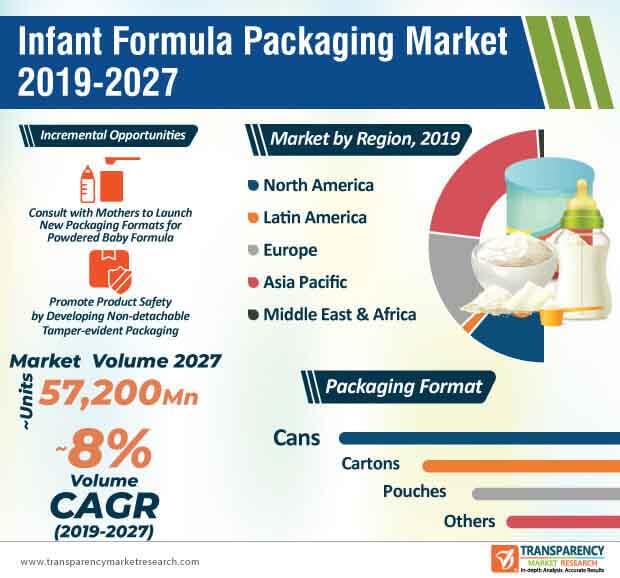
Surveys and Consultation with Mothers Give Rise to Perfect Dosing Systems
In order to gain a better understanding of a mother’s wants and needs, packaging companies in the infant formula packaging market are conducting surveys to innovate in new formats of packaging. For instance, one of Germany’s dairy cooperative DMK Group announced collaboration with A&R Carton— a European paperboard packaging solutions provider, to survey mothers from seven different countries to introduce new packaging formats for powdered baby formula. As such, the revenue of powdered form is projected for exponential growth and the infant formula packaging market is estimated to reach a value of ~US$ 3 Bn by the end of 2027.
Safety, convenience, and appealing design are some of the key focus points that are generating incremental opportunities for manufacturers in the market for infant formula packaging. In order to boost their credibility credentials in the infant formula packaging market, manufacturers are increasing their efficacy in perfect dosing systems and offering packaging formats that provide protection against bacteria.
Request a sample to get extensive insights into the Infant Formula Packaging Market https://www.transparencymarketresearch.com/sample/sample.php?flag=S&rep_id=76755

Tamper-evident Packaging Reassures Product Safety in Infant Formula Packaging Market
Safety and quality have become some of the top priorities of parents while choosing infant food products. In order to meet varying needs of buyers, manufacturers in the infant formula packaging market are innovating in non-detachable and tamper evident packaging to maintain the safety and quality of products. For instance, Shijiazhuang Junlebao Dairy Co., Ltd.— one of China’s dairy product companies, introduced their non-detachable tamper-evident tear band provided by global leader in dispensing systems for the company’s Youcui brand of premium and organic infant formula. China being one of Asia Pacific’s leading economy is boosting the growth of the market for infant formula packaging.
To understand how our report can bring difference to your business strategy, Ask for a brochure https://www.transparencymarketresearch.com/sample/sample.php?flag=B&rep_id=76755
Sleek, bi-injected closures are acquiring popularity in the market for infant formula packaging, which makes products look more premium and attract the attention of buyers in retail stores. Manufacturers are increasing their R&D activities to develop packaging solutions with unique designs that make it easy for buyers to spot product and reassure product safety.
Companies Replace BPA with BPS for Epoxy Lining in Canned Packaging
The infant formula packaging market is largely fragmented with tier 3 local and regional players accounting for ~68% – 77% of the global market share. Hence, packaging companies are increasing their production capabilities to develop detachable tamper-evident systems. However, risks of toxic chemicals entering through food packaging are some of the barriers that manufacturers in the market for infant formula packaging need to tackle.
For instance, bisphenol (BPA) compounds are used to make epoxy lining in metal cans. As such, the revenue of cans is anticipated for aggressive growth and highest revenue among packaging formats in the market landscape. However, BPA compounds are associated with endocrine disruption and reproductive toxicity among consumers. Hence, manufacturers are now replacing BPA with Bisphenol S (BPS) for infant formula packaging. Ongoing research is being conducted to validate whether BPS is an effective replacement for BPA. On the other hand, manufacturers in the infant formula packaging market are increasing the availability of innovative packaging solutions to help companies prepare baby formula that are safe and hygienic.
Sustainable Packaging Solutions Boost Credibility of Manufacturers in Global Market
Environment-friendly infant formula packaging solutions are being highly publicized in the market landscape. Such innovations are contributing toward the robust growth of the market, which is anticipated to expand at a CAGR of 8% during the forecast period. For instance, in February 2019, Greiner Packaging— Europe’s plastic packaging manufacturer, announced the launch of K3®-F packaging, which is a fully recyclable cardboard-wrap container for powdered formula. As such, the infant formula packaging market in Europe is projected to generate the second-highest revenue.
Companies in the infant formula packaging market are developing solutions that can be easily separated from one another before disposal. They are acquiring global recognition by agreeing to sign the New Plastics Economy Global Commitment launched by the U.K.-based Ellen MacArthur Foundation.
Stuck in a neck-to-neck competition with other brands? Request a custom report on Infant Formula Packaging Market https://www.transparencymarketresearch.com/sample/sample.php?flag=CR&rep_id=76755
Infant Formula Packaging Market: Overview
- Rising demand for safe and hygienic packaging of infant formula is anticipated to expand the global infant formula packaging market almost twice of its current value during the forecast period. In 2019, the global infant formula packaging market was valued at ~US$ 1.5 Bn and is expected to expand at a CAGR of 8% during the forecast period.
- Infant formula packaging products are specially designed as per the regulations of FDA. Various types of infant formula packaging are available, including plastic containers such as tubs, metal cans, cartons, and pouches. These packaging formats are best suitable packaging solutions for wet and dry infant formula. Low carbon impact packaging and easy to recyclable material are gaining more traction among end-users in the global infant formula packaging market.





